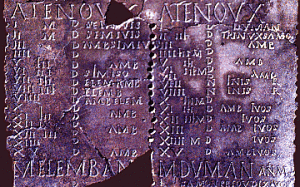Alexios Pliakos
Coligny Calendar, The
The Coligny Calendar is the name given to a fragmented bronze plaque discovered in 1897 near Coligny in France. It is a calendar that has been attributed to the Celtic Sequani tribe. It is dated to the 2nd century AD, written in Roman script in Gallic and is the longest known document in that language.
Paul Dunbavin in his Atlantis of the West[099] proposed that the Coligny Calendar might be considered a lunisolar calendar. Some years later in 2005 he returned to the subject in Under Ancient Skies[101] and devoted Chapter 5 plus Appendices A & B to a discussion of Critias 119d, which relates how the kings of Atlantis met alternatively every five and six years. Dunbavin suggests that this is reflected in the Coligny  Calendar and that it possibly had antecedents that would bring its functions back to the time of Bronze Age Atlantis>(d), if not earlier(e).<Dunbavin’s reaction to the Calendar is best quoted – Now it is this passage more than any other that convinces the present author (Dunbavin) of the authenticity of the Atlantis myth“. He touches on the subject again in his latest offering, Towers of Atlantis [1627] and Prehistory Papers [1758].
Calendar and that it possibly had antecedents that would bring its functions back to the time of Bronze Age Atlantis>(d), if not earlier(e).<Dunbavin’s reaction to the Calendar is best quoted – Now it is this passage more than any other that convinces the present author (Dunbavin) of the authenticity of the Atlantis myth“. He touches on the subject again in his latest offering, Towers of Atlantis [1627] and Prehistory Papers [1758].
Alexios Pliakos, a Greek student of ancient calendars, presented a paper to the 2008 Atlantis Conference entitled A hidden Calendar in the Atlantis Story. He focused on the same Critias 119d text and like Dunbavin has independently concluded that the reference to the five and six years is strong evidence “that Atlantis did not lie in Plato’s imagination.”
There have been attempts to link the Coligny Calendar with the much earlier stone engraving found at Knowth near Newgrange in Ireland(a). An extensive and more speculative discussion of the Calendar is to be found on a New Zealand website(b). Perhaps the most exotic explanation for the source of the Calendar, questions the presumed Celtic origins and offers reasons to consider a claim that it can be traced back to ancient India(c).
>A 2020 paper by Helen Mckay entitled The Coligny Calendar: A Full Reconstruction with Modern Dates from 30 April 2020 to 4 May 2025 is freely available.(f)<
(a) https://www.sequanicalendar.com/egg.html (Link broken Nov. 2018)
See: https://web.archive.org/web/20170305004709/https://www.sequanicalendar.com/egg.html
(b) http://www.celticnz.co.nz/Coligny/ColignyPart1.htm
(c) The Coligny Five Year Yuga | MalagaBay (archive.org)
(d) e5604c_465f3f96346041fb94f8e5f960804f1f.pdf (filesusr.com) *
(e) (99+) (PDF) The Neolithic Calendar in Plato’s Critias | Paul Dunbavin – Academia.edu *
Lunisolar Calendar
A Lunisolar Calendar is regulated by the positions of both the moon and the sun and has been in use since ancient times in many cultures(b), indicating the phases of the Moon as well as the passage of time through the solar year. The Jewish calendar is an example of an ancient lunisolar calendar still in use.
It is claimed that a lunisolar calendar is hidden within the Atlantis story according to a paper presented at the 2008 Atlantis Conference by Alexios Pliakos.
Pliakos believes[750.631] that Critias 119 d2-d4, which refers to the convening of the Atlantean kings every five and six years, contains a previously unknown lunisolar calendar of 11 years duration with an accuracy of 0.09 days per year. As he also claims that it could have been applied in both 9600 BC and 12th century BC, it cannot be used to date the time of Atlantis. However, he points out that this 11-year lunisolar calendar conforms with the development of calendars generally adding to the improbability of the Atlantis story being an invention.
>Jim Allen has written a paper about the identification of a Lunisolar calendar at Tiwanaku(e).<
In a recent paper by Ashley Cowie, he explains how the Hittite shrine of Yazilikaya, at least in part, could have been used as a lunisolar calendar. Eberhard Zangger, an expert on the ancient history of the region, has also identified astronomically related features at the site (d).
Paul Dunbavin, in his Atlantis of the West[0099.319], has offered a speculative explanation for the fifth and sixth-year meetings of the Atlantean kings based on the fragments that make up the French ‘Coligny Calendar’(a).
David Ohrenstein has a short blog on the significance of ‘five and six’ from megalithic times to that of the Egyptians and later the Maya(c).
(a) The Gaulish (Coligny) Calendar (archive.org)
(b) https://en.wikipedia.org/wiki/Lunisolar_calendar
(c) Clues in the Search for Atlantis Come With # 5 and #6. – DSO Works (archive.org)
(d) https://www.ancient-origins.net/news-history-archaeology/astronomical-observatory-0012230
(e) https://www.academia.edu/27669972/Tiwanaku_cubits_and_Calendar See Part 2 *
